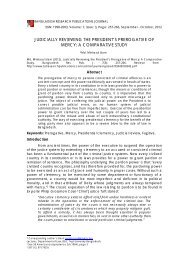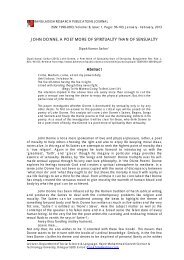agricultural growth and agricultural credit in the context of bangladesh
agricultural growth and agricultural credit in the context of bangladesh
agricultural growth and agricultural credit in the context of bangladesh
Create successful ePaper yourself
Turn your PDF publications into a flip-book with our unique Google optimized e-Paper software.
Agricultural Growth <strong>and</strong> Agricultural Creditcostly f<strong>in</strong>anc<strong>in</strong>g option that is available only <strong>in</strong> <strong>the</strong> major cities, with a pre-requisite <strong>of</strong>f<strong>in</strong>ancial-collateral. In order to address <strong>the</strong> issue <strong>the</strong> GoB can make <strong>the</strong> f<strong>in</strong>anc<strong>in</strong>g choiceseasier <strong>in</strong> terms <strong>of</strong> <strong>in</strong>troduc<strong>in</strong>g favorable <strong>agricultural</strong>-<strong>credit</strong> guarantee <strong>and</strong> reduc<strong>in</strong>gadditional overhead <strong>in</strong>terest <strong>in</strong> cases <strong>of</strong> NGO-MFIs. The same was also suggested <strong>in</strong> case<strong>of</strong> a research held by Gloy et al. (2005).In addition to <strong>the</strong> above, any loop-holes discovered <strong>in</strong> <strong>the</strong> research, <strong>in</strong> <strong>the</strong> way <strong>of</strong> delivery<strong>of</strong> <strong>credit</strong> to <strong>the</strong> respective recipient <strong>of</strong> <strong>the</strong> same, will educate <strong>the</strong>m about alternativefeasible <strong>credit</strong>-options. In ano<strong>the</strong>r research by Mehmood et al., (2012) on Kasur District <strong>of</strong>Pakistan, showed that <strong>in</strong> some cases it can be common for many villagers, to take-uploan show<strong>in</strong>g that as an <strong>in</strong>vestment <strong>in</strong>to agriculture <strong>and</strong> agro-based activities, but <strong>in</strong>reality putt<strong>in</strong>g that <strong>in</strong>to social expenses like carry<strong>in</strong>g out marriage occasions, dowry,dissolv<strong>in</strong>g legal cases etc. Practices like this raise questions on to <strong>the</strong> issues <strong>of</strong> <strong>the</strong>effectiveness <strong>of</strong> <strong>the</strong> disbursed <strong>credit</strong>, if gett<strong>in</strong>g <strong>in</strong>to <strong>the</strong> paradigm <strong>of</strong> <strong>agricultural</strong>production, <strong>in</strong> <strong>the</strong> first place, let alone its role <strong>in</strong> <strong>in</strong>creas<strong>in</strong>g it.It has been noted <strong>in</strong> some previous research (Badiru, 2010; Rahman et al., 2011; CDF, 2006;Rahman, 2004; Gloy et al., 2005) that <strong>the</strong> cost <strong>of</strong> avail<strong>in</strong>g <strong>the</strong> <strong>credit</strong> also h<strong>in</strong>ders <strong>the</strong>farmers’ capacity to get <strong>the</strong> f<strong>in</strong>ance. As cited <strong>in</strong> a work<strong>in</strong>g paper by Nagarjan <strong>and</strong> Meyer(2005), <strong>the</strong> different costs that add up to <strong>the</strong> available f<strong>in</strong>ance schemes, range fromservice charge for high volume <strong>of</strong> multiple transactions <strong>of</strong> lesser amounts <strong>of</strong> <strong>the</strong> users, to<strong>the</strong> cost for provid<strong>in</strong>g <strong>the</strong>m with <strong>in</strong>formation about <strong>the</strong>ir sav<strong>in</strong>gs or <strong>credit</strong> accounts severaltimes, <strong>in</strong> contrast to any urban account holder. This is due to <strong>the</strong> fact that, <strong>in</strong> contrast to<strong>the</strong> account-holders <strong>of</strong> metropolitan areas, <strong>the</strong> rural account holders live more scattered<strong>and</strong> based on <strong>the</strong>ir earn<strong>in</strong>g, both <strong>the</strong>ir sav<strong>in</strong>gs <strong>and</strong> requirement for f<strong>in</strong>ance is alsocomparatively low (Nagarjan <strong>and</strong> Meyer, 2005). Thus a proper balance <strong>of</strong> cost between<strong>the</strong> lender <strong>and</strong> borrower <strong>of</strong> f<strong>in</strong>ance must be established (Mehmood et al., 2012).O<strong>the</strong>rwise, <strong>the</strong> agri-<strong>credit</strong> payout may not aga<strong>in</strong>, be an <strong>in</strong>put <strong>in</strong> <strong>in</strong>creas<strong>in</strong>g <strong>the</strong> <strong>agricultural</strong>production.In many o<strong>the</strong>r preced<strong>in</strong>g researches, pro<strong>of</strong> <strong>of</strong> a positive association between <strong>agricultural</strong><strong>credit</strong><strong>and</strong> higher productivity has been established. Numerous former studies havestressed on <strong>the</strong> improvement <strong>of</strong> <strong>the</strong> f<strong>in</strong>ancial segment, as ensur<strong>in</strong>g a better accessible<strong>and</strong> approachable rural fund-source can positively re<strong>in</strong>force productivity (Lev<strong>in</strong>e et al.,2000, McMillan <strong>and</strong> Woodruff, 2002; Cull <strong>and</strong> Xu, 2005). Butler <strong>and</strong> Cornaggia (2009) alsohave explored positive connection between countries with easier fund access <strong>and</strong> raisedproductivity. If people have easier access to gett<strong>in</strong>g funds, more <strong>of</strong> that money can beput <strong>in</strong>to sett<strong>in</strong>g up a bus<strong>in</strong>ess, develop<strong>in</strong>g new skills <strong>and</strong> expertise, explor<strong>in</strong>g product<strong>in</strong>novation, assur<strong>in</strong>g proper allocation <strong>of</strong> resources, all <strong>of</strong> which can lead to expansion<strong>and</strong> <strong>growth</strong>. In o<strong>the</strong>r words, <strong>the</strong> size <strong>of</strong> <strong>the</strong> exist<strong>in</strong>g bus<strong>in</strong>ess can be enlarged with <strong>the</strong>support <strong>of</strong> trouble-free money access (Beck et al, 2005).S<strong>in</strong>ce <strong>the</strong> liberation <strong>of</strong> Bangladesh <strong>in</strong> 1971, <strong>the</strong> economy first <strong>and</strong> foremost depended on<strong>the</strong> <strong>agricultural</strong> sector. Agriculture rema<strong>in</strong>s very important, as it is <strong>the</strong> prerequisite to ensurefood security <strong>and</strong> is <strong>the</strong> major source <strong>of</strong> employment <strong>and</strong> livelihood, to <strong>the</strong> greatestnumber <strong>of</strong> people <strong>in</strong> Bangladesh, as well as its contribution through forward <strong>and</strong>backward l<strong>in</strong>kage with <strong>the</strong> rest <strong>of</strong> <strong>the</strong> economy (Asaduzzaman, 2009). Without do<strong>in</strong>gproper utilization <strong>of</strong> this sector, <strong>the</strong> overall economic improvement will not emerge.Keep<strong>in</strong>g <strong>in</strong> l<strong>in</strong>e, with <strong>the</strong> importance <strong>of</strong> this sector, <strong>the</strong> Bangladesh Government hasallocated a considerable portion <strong>of</strong> <strong>agricultural</strong> <strong>credit</strong> <strong>and</strong> also encourages o<strong>the</strong>rorganizations (NGO-MFIs, PCBs, FCBs etc.) to extend <strong>the</strong>ir lend<strong>in</strong>g facilities to this field.Apart, from reduc<strong>in</strong>g customer duty on commodities <strong>in</strong> <strong>the</strong> budget <strong>of</strong> f<strong>in</strong>ancial year 2010-11, an allocation <strong>of</strong> Tk. 4,000 corer has been proposed as subsidy to <strong>the</strong> <strong>agricultural</strong> sector(State <strong>of</strong> <strong>the</strong> Bangladesh Economy <strong>in</strong> FY2010-11: First read<strong>in</strong>g). With <strong>the</strong> reference <strong>of</strong> thispaper, State <strong>of</strong> <strong>the</strong> Bangladesh Economy <strong>in</strong> FY2010-11, which is prepared under <strong>the</strong>program called Independent Review <strong>of</strong> Bangladesh’s Development (IRBD) state thatBangladesh is currently negotiat<strong>in</strong>g with IMF for a <strong>credit</strong> deal amount US$ 1(one) Billion forthree years (2011-14) under its Extended Credit Facility (ECF) arrangement. Accord<strong>in</strong>g to<strong>the</strong> center for Policy Dialogue (CPD) Bangladesh, a clearance for loan package isexpected to get from IMF Board <strong>in</strong> February next year. This would be <strong>the</strong> first time <strong>in</strong> threeyears that Bangladesh is opt<strong>in</strong>g for an IMF program. In FY2009-10, <strong>the</strong> GoB allocated Tk.5,965 corer for agriculture sector, <strong>of</strong> which Tk. 5,076 cores were assigned for <strong>the</strong> non-177http://www.bdresearchpublications.com/journal/
















